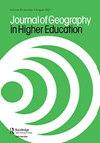基于地点的混合式学习方法
IF 1
4区 教育学
Q2 EDUCATION & EDUCATIONAL RESEARCH
引用次数: 5
摘要
课程设置的灵活性比以往任何时候都更需要。混合学习、翻转课堂方法和体验式学习,在混合环境中重新设想,为解决当前高等教育提供的挑战提供了机制。如今,大学更加强烈地考虑将在线学习作为使校园资产多样化的一种方式,学生对学习方式和地点(包括传统的实体学习)的选择要求更为普遍,教师尝试在线教学的程度令人震惊。地理是一门以自然地点和当地社区为基础的学科,开发灵活的学习空间,无论学生在哪里或如何学习,都能保持与地点的联系,这是一项挑战。一项试点研究考察了澳大利亚和新西兰的教师对混合学习和数字媒体内容创作的理解,用于开发基于地点的混合学习的初步框架。该框架响应了不断变化的学生和教师需求以及教学和学习中的数字化转型,同时培养了归属感和对地方的联系。本文章由计算机程序翻译,如有差异,请以英文原文为准。
A place-based approach to blended learning
ABSTRACT Flexibility in course provision is needed more than ever. Blended learning, flipped classroom approaches and experiential learning, re-envisioned within hyflex environments, offer mechanisms for addressing current challenges in tertiary education provision. Today, universities are more intensely considering online study as a way to diversify campus assets, student requests for choice in how and where they study (including the traditional brick-and-mortar experience) is more widespread, and the extent to which instructors are experimenting with online provision is staggering. In geography, a discipline grounded in physical places and local communities, developing flexible learning spaces that retain that engagement with place, regardless of where or how students are studying, is challenging. A pilot study examining Australian and Aotearoa New Zealand instructors’ understandings of blended learning and digital media content creation is used to develop a preliminary framework for place-based blended learning. This framework responds to changing student and instructor needs and digital transformations in teaching and learning yet fosters a sense of belonging and connection to place.
求助全文
通过发布文献求助,成功后即可免费获取论文全文。
去求助
来源期刊

Journal of Geography in Higher Education
Multiple-
CiteScore
5.80
自引率
9.50%
发文量
29
期刊介绍:
The Journal of Geography in Higher Education ( JGHE) was founded upon the conviction that the development of learning and teaching was vitally important to higher education. It is committed to promote, enhance and share geography learning and teaching in all institutions of higher education throughout the world, and provides a forum for geographers and others, regardless of their specialisms, to discuss common educational interests, to present the results of educational research, and to advocate new ideas.
 求助内容:
求助内容: 应助结果提醒方式:
应助结果提醒方式:


